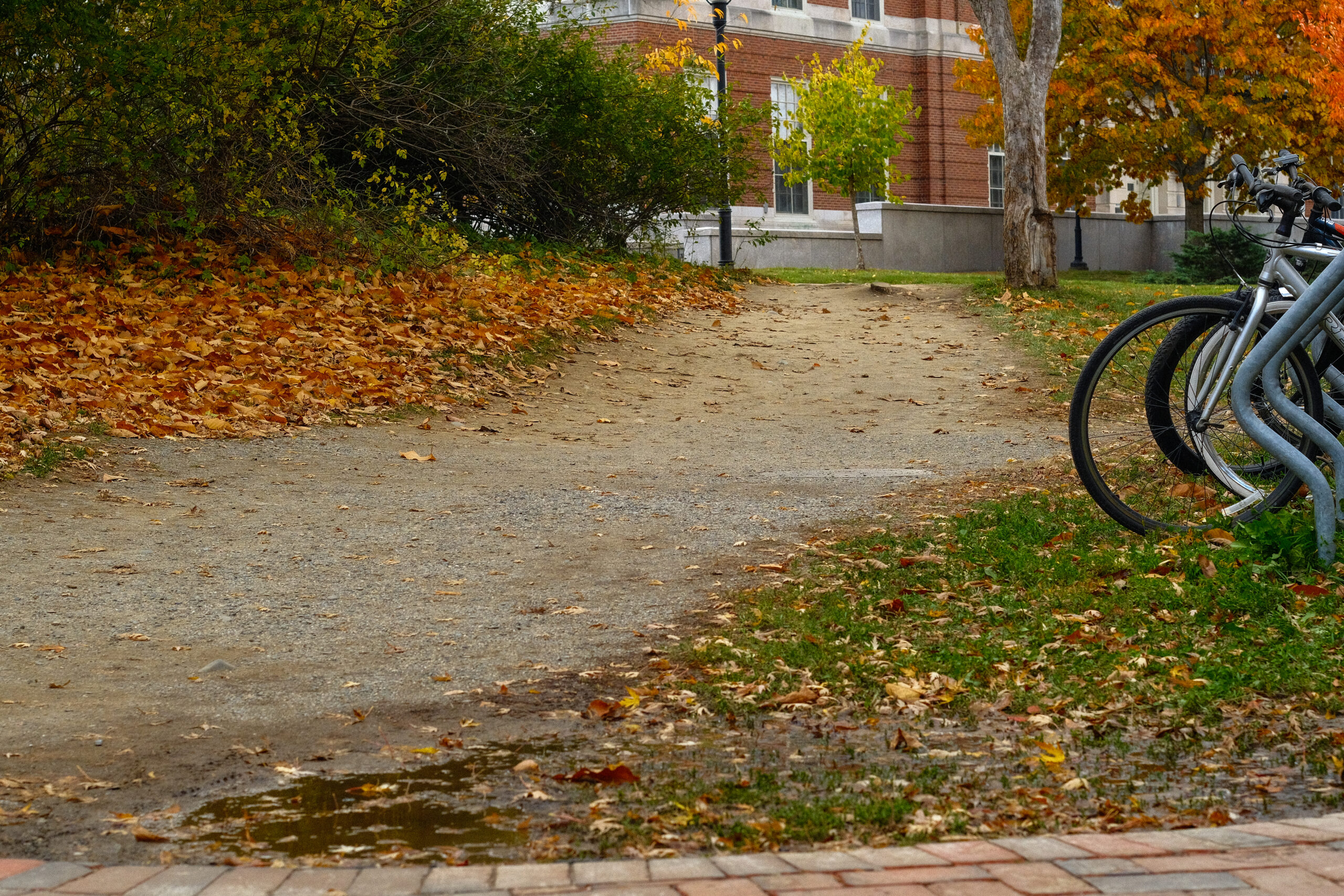The little dirt off-shoot of the pavement, soft ground underfoot replacing hard rock. Getting to your class a little faster, wandering a little more. It is likely that everyone reading this has, at some point, walked on a desire path. It could be as conscious as an incorporated part of your schedule in order to get between classes on time or so unconscious that you have never realized what they are.
A desire path is an unplanned small trail formed by erosion caused by human or animal traffic. And they are all around us on such a green, grassy campus.
“I don’t think intentionality has much to do with it,” said Jeffrey Benjamin, a professor of contemporary anthropology at the university, “They seem like the most natural thing in the world. They seem as natural as the paths that caribou or deer might create.” Benjamin commented on how many of the paths we create are those that are formed as the path of least resistance. Because of this fact, many of our now-established pathways in New England were actually started by our animal ancestors.
“One of the roads I find interesting on campus is Munson Road; it doesn’t need to do that little curve, but it’s what you might do if you were walking,” Benjamin noted, adding how the University’s agricultural history may have something to do with this. Despite the fact that they often expedite our travels across campus, many desire paths take similar bends as does Munson Road.
“I think it is an innate desire to be closer to nature,” Benjamin thought on this idea of people choosing to wander in a space with very demarcated pathways. He fondly remembered a time at another University where he taught, “I don’t remember any paving on campus at all. The buildings were modern but they hadn’t paved any paths. It was nice to feel like I was walking through a rural setting.”
But what about the soft ground and a feeling of wandering— breaking from the established path— draws so many of us in?
“I think most of the time, when we are walking around, we have lots of other thoughts in our minds. When we see desire paths we might choose that to exert greater agency— personal agency,” Benjamin mused. Certainly, if we are ‘exploring’ our thoughts internally, it is more conducive to ‘explore’ the environment around us in turn.
However, we do not wander fully off the path. We take something set out in front of us not by a formal institution, but by a large conglomerate of people.
“Using a desire path is personal but you also feel connected to a community— a community of other people who started it and kept it going,” Benjamin spoke on the idea that truly, a desire path, in its creation, forms a community of people. We feel connected to the other people who have ventured outside the paved pathways and, in a way, take more seriously the paths created by repeated use of feet than those laid quickly by machinery.
“The best gift I had when I got here was that my car broke down, so I had to walk into Orono everyday to get groceries. It forced me to see campus,” Benjamin is new to the University of Maine and much of his introduction to campus has been on foot. There is something to be said that if walking forces one to really see something, then taking a different path forces one to see in a new way.
“There’s a lot of very good reasons to have a beautiful campus. It’s uplifting, I find I have better thoughts when I am walking through nature, I get inspiration. I think we need all these things— like desire paths— or paths through the woods that can take us away from the hustle and bustle, you know, the business— the frenetic activity of the everyday,” Benjamin spoke for many of us, especially with that last point. We associate walking in the woods with meditation, calmness, and introspection. These things can be hard to achieve on the busiest pathways on campus— what Benjamin called the “superhighways” of the university.
We already understand that many of the paths we use are started by nonhuman animals, but there is an even more direct connection we share when it comes to pathways.
“We share these paths with other people, but also cars, robots, and every now and then animals. Support animals and things like that, but also squirrels,” Benjamin talked about how paths do not belong to us alone. Additionally, there is something to be said about how much more welcoming dirt paths are to animals.
Individuals carving their own paths into a landscape is not unique to universities or to the necessity of arriving somewhere quickly.
“We see it in public parks everywhere. There is the ‘garden city’ ideal which originated as an urban planning phenomena. People recognized this need for nature so they tried to intermingle nature with the urban,” Benjamin noted about the phenomena of curvilinear and foot-carved pathways even in the most urban places on the planet. Central Park in New York City was created in this image of the “garden city.”
Then, in some sense, we are not only a part of the community of others who have carved our own individual paths, but a part of the human tradition of path-making. It is in our nature to move— even our thinking is encouraged by physical movement— and we understand that about one another. Maybe walking off the beaten path is our own way of exerting some agency on our own thinking; a microcosm of the attempt to feel individual in a place with (literal and figurative) pathways already laid out for us.








